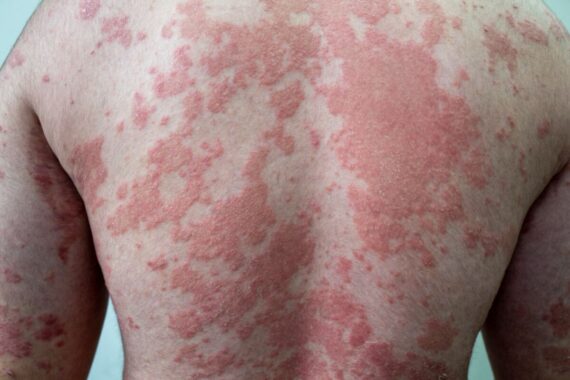
As part of our series highlighting some of the best seminars at Pulse Live, Dr Paul Charlson summarises his talk on supporting patients with psoriasis in general practice
Psoriasis commonly develops in young people or in people in their sixth or seventh decade. It is strongly heritable. 4% of people with no family history of psoriasis develop it, compared to 28% of people with one parent with psoriasis and 65% of people with two parents with psoriasis.
In one study 31% of all psoriasis patients had a family history. These patients were more likely to be younger, female and present with more nail and joint disease. (Solmaz D, et al 2020). Ask about family history in anyone with possible psoriasis.
Psoriasis is commoner in smokers. Stress is a common trigger as is injury (causing the Koebner phenomenon) and hormone changes in women (Xhaja et al 2014) . Other triggers are lithium, beta blockers, NSAIDs and (in guttate psoriasis) Streptococcus infection. However, these triggers are so common that they are rarely helpful diagnostically except to build the picture.
There are many types of psoriasis which makes diagnosis potentially difficult.
The types are:
- Guttate
- Chronic plaque
- Planto-palmar pustulosis
- Scalp
- Facial
- Nail
- Flexural
.
Examination
In psoriasis the skin turnover is greatly increased leading to a build-up of skin and scale causing scaly plaques.
The scalp is a common site with dry scales and plaques which can look like dandruff. Check the margins of the scalp[KH1] [AS2] and behind the ears for scaly plaques as these are a common sites for psoriasis and maybe the only sign. The extensor surfaces of the elbows and knees often have dry, scaly plaques which are usually well demarcated. Look also for signs in the umbilicus, natal cleft and genitalia and in the nails. Usually following this examination diagnosis is easy.
Guttate psoriasis usually occurs abruptly, often after an URTI. It consists of multiple teardrop lesions all over the body. It generally resolves after a few months.
Chronic plaque psoriasis is the commonest form. This produces large well demarcated plaques with a ruby red appearance and a silvery scale, often symmetrical in distribution. Smaller more diffuse plaques can occur. If the plaques are not well defined and itchier the patient probably has discoid eczema (rarely is this fungal). If you scrape off the scale in psoriasis it tends to pinpoint bleed (Auspitz sign).
In the nails look for micro-pits, oncholysis where the nail separates from the bed, subungal hyperkeratosis and oil drop / salmon pink patches.
Always ask about the genitalia where psoriasis often manifests as well-defined plaques. The groin and natal cleft are also affected[AS3] with similar looking plaques. In these areas there is rarely scale and the skin can crack in the flexure. However, the plaques are well defined and cherry red which defines it as psoriasis.
Facial psoriasis is uncommon. Often it looks like seborrhoeic dermatitis and more rarely defined plaques. If this is present, consider discoid lupus[KH4] as a differential diagnosis.
Planto-palmar psoriasis occurs in smokers, mainly women over 50. This is an erythematous condition with yellow pustules and brown macules and scale, often affecting heel and insteps.
Treatment
Scalp psoriasis is unpleasant to treat. If the main issue is itch, Enstilar foam is useful. It should be applied directly to the scalp and not onto the hair. Patients should allow it to dry, preferably overnight, and wash out with shampoo. Four weeks is considered a reasonable treatment time. For scale, betamethasone with salicylic acid scalp application is applied overnight and washed out with shampoo the following morning. Patients should use a tar-based shampoo twice weekly.
Plaque psoriasis is treated using emollients applied thickly and allowed to dry. They can apply calcipotriol and betamethasone cutaneous foam until the plaques flatten, for a maximum of four weeks (although you can extend this time up to eight weeks with care). Maintain using foam twice weekly. For large plaques calcipotriol or coal tar lotion can be used to reduce steroid use.
Guttate psoriasis is often managed with emollients but you can add in coal tar lotion. Sunshine can be helpful.
For the face, tacrolimus [KH5] ointment bd [KH6] [AS7] , topical corticosteroid cream for the hair margins and emollients are usually effective. Tacrolimus is not licensed for psoriasis but is used worldwide so GPs can be confident to use it “off label”.
Genital psoriasis is problematic and unpleasant so treat seriously. Emollients are the mainstay with short courses (maximum 2 weeks) of topical corticosteroid applied to plaques. Calcipotriol[KH8] is helpful as is tacrolimus [KH9] ointment[AS10] .
Treatment for planto-palmar psoriasis is the same as for plaque psoriasis. If there is excessive scale use betamethasone dipropionate and salicylic acid ointment and if there are significant issues on the soles with pustules, clobetasol propionate cream od for 2 weeks can be helpful.
Nail psoriasis is difficult to treat. Take scrapings for fungal infection and treat if required, otherwise it is best to refer for systemic treatment.
If you are struggling to manage psoriasis it is best to refer to the dermatology department sooner rather than later. Children are best referred straightaway but, in the meantime, manage as with adults.
Light treatment is effective in cases of psoriasis. Drugs such as ciclosporin, acetretin, and methotrexate can be transformative. Biologics are even better but are less easy to obtain.
Dr Paul Charlson is a GPwSI in dermatology in London
References
Solmaz D, Bakirci S, Kimyon G, Gunal EK, Dogru A, Bayindir O, Dalkilic E, Ozisler C, Can M, Akar S, Cetin GY, Yavuz S, Kilic L, Tarhan EF, Kucuksahin O, Omma A, Gonullu E, Yildiz F, Ersozlu ED, Cinar M, Al-Onazi A, Erden A, Tufan MA, Yilmaz S, Pehlevan S, Kalyoncu U, Aydin SZ. Impact of Having Family History of Psoriasis or Psoriatic Arthritis on Psoriatic Disease. Arthritis Care Res (Hoboken). 2020 Jan;72(1):63-68. doi: 10.1002/acr.23836. PMID: 30680951
Xhaja A, Shkodrani E, Frangaj S, Kuneshka L, Vasili E. An epidemiological study on trigger factors and quality of life in psoriatic patients. Mater Sociomed. 2014 Jun

Pulse 365 LIVE Events cover a broad array of topics pertinent to you, your patients, and your practice. You will gain free CPD and be able to take part in live Q&As. Specifically created for all practising, GMC-registered GPs and trainees, you will hear from experts across primary and secondary care, and network with like-minded GPs. Sign up for your nearest event today.
Pulse October survey
Take our July 2025 survey to potentially win £1.000 worth of tokens














